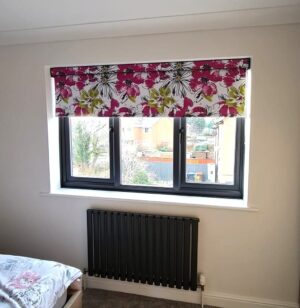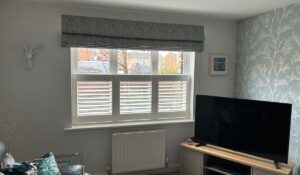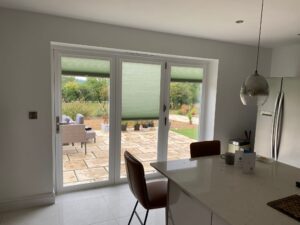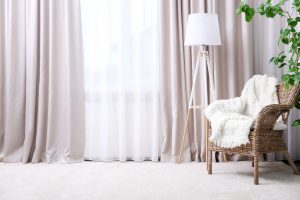The Science of Cosy: U-values, Thermal Linings & Honeycomb Fabrics Explained
When the nights draw in and the thermostat starts winking at you, “cosy” becomes a science as much as a feeling.
The good news is you don’t need an engineering degree to warm up your home.
With a plain-English grasp of U-values, thermal linings and honeycomb fabrics, you can trap more heat, trim your energy bills and still make your windows look effortlessly stylish.
What on Earth is a U-value?
Think of a U-value as a “leaky score” for heat. It measures how easily warmth escapes through a material. The lower the number, the better the insulation.
A single sheet of glass, for example, has a relatively high U-value because heat slips through it quickly. Add a smart blind, a lined curtain or a cellular/Duette shade, and you’re effectively lowering the overall U-value of the window area – like popping a snug jumper over a T-shirt.
In short: high U-value means draughty and chilly; low U-value means snug and toasty.
How Heat Escapes – and How to Outsmart It
Heat leaves a room in three main ways: conduction, convection and radiation.
Conduction is heat sneaking through solids such as glass and frames. Convection is that tiny loop of air that cools as it brushes the cold window and then cycles around the room. Radiation is warmth beaming towards a colder surface, like sunlight on a winter’s day but in reverse.
You don’t need to memorise the physics. Just remember that thicker fabrics, added layers and materials that trap still air will slow all three routes of escape. Installing window dressings close to the glass and sealing gaps at the edges multiplies the effect.
Thermal Linings: The Quiet Heroes
Thermal linings are the fleece inside your favourite winter coat – mostly hidden, quietly brilliant.
A standard thermal lining adds a discreet barrier that slows heat loss without changing the drape too much, making it ideal for living spaces where you want softness with subtle performance.
Blackout thermal linings do double duty, blocking light for better sleep while bouncing heat back into the room at night. If you want another step up, interlining adds a plush layer between fabric and lining.
That additional thickness traps more air, which acts like a duvet for your windows. The result is a cosier room and a more luxurious, tailored look.
Honeycomb (Duette) Blinds: Small Pockets, Big Gains
Honeycomb, or Duette, blinds are the clever bees of the window world. Slice one in cross-section and you’ll see a stack of hexagonal cells, each trapping a layer of still air.
Air is a superb insulator when it’s kept still, so those pockets work hard for you all winter. Because the blinds sit close to the glass, they reduce the cold downdraft and act as a shield against conductive heat loss.
In summer, the same design helps keep heat out, creating year-round comfort. If your aesthetic leans minimal, honeycomb blinds offer sleek lines and a broad palette of colours without sacrificing performance.
Layering for Beauty and Brains
You don’t have to choose between practical and pretty. The most effective and stylish approach is to layer. A perfect-fit cellular blind tucked neatly in the frame can provide daytime insulation, while full-length curtains with thermal lining add drama and extra warmth after dusk.
Roman blinds with interlining paired with wave-heading curtains give a tailored, hotel-suite finish that feels rich and cocooning. Even shutters can join the party: they cut draughts and add privacy, while curtains soften the look and improve thermal performance.
The layers work together, each one adding resistance and creating pockets of still air that slow heat loss.
The Fit Matters as Much as the Fabric
Even the cosiest fabric can underperform if heat escapes around the edges. Consider mounting tracks wider and higher than the window so curtains overlap the frame, reducing light bleed and cold edges.
Curtains that return to the wall at the sides help seal off draughts, while a slight puddle or a hem that just kisses the floor blocks cold air pooling near the sill.
Tidying up the top gap with a pelmet or a deeper header reduces the chimney effect where warm air rises behind the curtain. These small tweaks can add up to a noticeable difference in comfort.
Daily Habits That Save Real Money
Insulation works hardest when you use it wisely.
Close blinds and curtains at dusk to lock in the day’s warmth; as the light fades, the glass temperature drops and heat loss accelerates. On crisp, sunny mornings, open up to welcome free solar gain and let the sun do a bit of the heating for you.
Over a season, these small habits, combined with better linings or cellular shades, translate into fewer boiler cycles and lower bills. If you’re on a tight budget, simple fixes like draught-proofing strips around frames or brush seals on doors can punch far above their weight.
Style That Works as Hard as It Looks
Performance doesn’t have to look utilitarian. Tone-on-tone layers – say, an oatmeal curtain over a stone cellular blind – feel calm and considered.
Textured weaves, such as bouclé or slub-linen looks, read visually warm, especially when interlined. Matte finishes reduce glare and make evenings feel more cocooning, while thoughtful hardware choices, from brushed brass to matte black, can pull the scheme together.
The aim is for the insulation story to disappear into the design so the room feels intentionally cosy, not clinically optimised.
A Quick Mental Checklist Before You Buy
Before you commit, ask yourself a few simple questions.
Is the fabric lined – and would a thermal or blackout option suit the room’s purpose? Would interlining elevate both look and warmth?
Do you prefer the slim profile of a honeycomb blind or the soft layers of curtains and romans? Can you improve the fit with wider tracks, returns or a pelmet?
And have you planned a day-night routine that lets you capture the sun’s heat and then seal it in?
The Cosy Conclusion
Making your home warmer isn’t guesswork or gadgetry; it’s understanding how heat moves and outsmarting it with layers, air pockets and good fit.
Lower the effective U-value of your window area with thermal linings, interlinings and honeycomb cells, and you’ll feel the difference in both comfort and cost. Best of all, you can do it with style – windows that look beautifully dressed by day and wrap you in a warm, welcoming glow by night.
Should you need any more information about our ranges of blinds, shutters and bespoke furniture, then please feel free to contact us. Alternatively, you can also arrange a home visit within one of the vast areas we cover.










